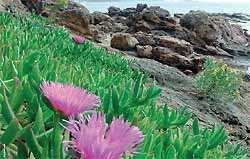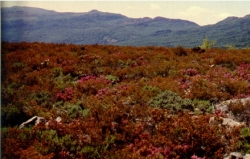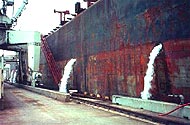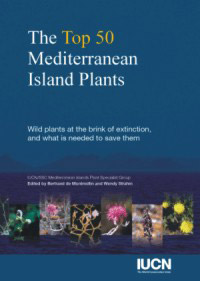|
|
|
|
|
|
Regional Red List of Continental Fish, Reptiles and Amphibians
 To compile the first red lists for the Mediterranean region, the IUCN's Centre for Mediterranean Cooperation (IUCN-Med) collaborated with the Union’s Species Specialist Group and the Centre for Applied Biodiversity Science at Conservation International (CI/CABS) to organise two workshops. Held in December 2004, the workshops brought together more than 50 experts in the region to work on the drawing up of Red Lists for endemic continental fish, amphibians and reptiles. Preliminary results indicate that according to Red List criteria, 56% of endemic continental fish in the Mediterranean are threatened, 18% being 'Crítically endangered', 18% 'Endangered' and 20% 'Vulnerable'. To compile the first red lists for the Mediterranean region, the IUCN's Centre for Mediterranean Cooperation (IUCN-Med) collaborated with the Union’s Species Specialist Group and the Centre for Applied Biodiversity Science at Conservation International (CI/CABS) to organise two workshops. Held in December 2004, the workshops brought together more than 50 experts in the region to work on the drawing up of Red Lists for endemic continental fish, amphibians and reptiles. Preliminary results indicate that according to Red List criteria, 56% of endemic continental fish in the Mediterranean are threatened, 18% being 'Crítically endangered', 18% 'Endangered' and 20% 'Vulnerable'.
|
|
|
| |
|
| Mediterranean results |
The Development of Mediterranean Red Lists of threatened Species is promoted
Tools for monitoring and evaluation of the situation of different Mediterranean species and ecosystems are developed |
|
|
|
| |
|
| |
|
| |
|
|
|
International Workshop on Invasive Plants in Mediterranean Type Regions of the World. Mèze (France), 25-27 May 2005
 IUCN-Med in partnership with the Porquerolles National Mediterranean Botanical Conservatory (France), the Council of Europe and the European and Mediterranean Plant Protection Organization (EPPO) organised an international workshop attended by more than 110 experts from the governments and institutions of 27 different countries. Among the different Working Groups initiated at this workshop, IUCN-Med leads the group on Mediterranean islands and invasive plants. Participants also approved the 'Declaration of Mèze', which gathers together a series of recommendations for the management of invasive plants. IUCN-Med in partnership with the Porquerolles National Mediterranean Botanical Conservatory (France), the Council of Europe and the European and Mediterranean Plant Protection Organization (EPPO) organised an international workshop attended by more than 110 experts from the governments and institutions of 27 different countries. Among the different Working Groups initiated at this workshop, IUCN-Med leads the group on Mediterranean islands and invasive plants. Participants also approved the 'Declaration of Mèze', which gathers together a series of recommendations for the management of invasive plants.
|
|
|
| |
|
| Mediterranean results |
Knowledge concerning invasive species colonisation processes and impacts are improved.
Tools to monitor and assess the situation of a range of Mediterranean species and ecosystems are developed |
|
|
|
| |
|
| |
|
| |
|
|
|
Support to Morocco in the Introduction of the Global Strategy for Plant Conservation of the Convention on Biological Diversity (CDB)
 IUCN-Med took part in the development of a PDF-B project which has been accepted for full consideration by the United Nations Environment Programme/Global Environment Facility (UNEP/GEF). The Project ‘s purpose is to introduce the Global Strategy for Plant Conservation of the Convention on Biological Diversity in Morocco by identifying the country’s endangered plants and protecting its important plant areas (IPAs). During the run-up to this process, IUCN-Med and Plantlife International organised a workshop at the Université Mohamed V in Rabat. Here, more than 30 conservation scientists and government representatives from throughout Morocco provisionally identified 53 important plant areas (IPAs) including 15 priority areas. IUCN-Med took part in the development of a PDF-B project which has been accepted for full consideration by the United Nations Environment Programme/Global Environment Facility (UNEP/GEF). The Project ‘s purpose is to introduce the Global Strategy for Plant Conservation of the Convention on Biological Diversity in Morocco by identifying the country’s endangered plants and protecting its important plant areas (IPAs). During the run-up to this process, IUCN-Med and Plantlife International organised a workshop at the Université Mohamed V in Rabat. Here, more than 30 conservation scientists and government representatives from throughout Morocco provisionally identified 53 important plant areas (IPAs) including 15 priority areas.
|
|
|
| |
|
| Mediterranean results |
Implementation of the Rio Conventions and other international agreements (Bern Convention, Ramsar, CMS, CITES…) is supported in the region and synergies that promote their implementation identified
|
|
|
|
| |
|
| |
|
| |
|
|
|
Ship Ballast Water: Main Vector of Marine Invasive Species in the Mediterranean Sea
 The IUCN-Med report on one of the main factors in the introduction of invasive marine species into Mediterranean waters suggests a series of measures to standardise the research and procedural focus across different countries. Invasive marine species are known to be one of the most significant threats to global biodiversity. This marine bio-invasion is more likely to affect the Mediterranean Sea due to the wide range of temperature in its waters, its high volume of maritime traffic and the presence of aquacultural activities. One of the main vectors of introduction is the ballast water that is a direct result of maritime traffic. IUCN-Med is also taking part in workshops organised by the Barcelona Convention’s Regional Activities Centre for Specially Protected Areas (RAC/SPA) on invasive marine species. The IUCN-Med report on one of the main factors in the introduction of invasive marine species into Mediterranean waters suggests a series of measures to standardise the research and procedural focus across different countries. Invasive marine species are known to be one of the most significant threats to global biodiversity. This marine bio-invasion is more likely to affect the Mediterranean Sea due to the wide range of temperature in its waters, its high volume of maritime traffic and the presence of aquacultural activities. One of the main vectors of introduction is the ballast water that is a direct result of maritime traffic. IUCN-Med is also taking part in workshops organised by the Barcelona Convention’s Regional Activities Centre for Specially Protected Areas (RAC/SPA) on invasive marine species.
|
|
|
| |
|
| Mediterranean results |
Knowledge concerning invasive species colonisation processes and impacts are improved.
Key Mediterranean ecosystems are assessed, drivers affecting their degradation are identified and actions for their conservation elaborated |
|
|
|
| |
|
| |
|
| |
|
|
|
The "Top 50" Mediterranean island plants threatened with extinction
 The publication “Top 50” Mediterranean island plants threatened with extinction produced by the World Conservation Union (IUCN), was presented at the 14th Ordinary Meeting of the Contracting Parties to the Barcelona Convention for the Protection of the Mediterranean Sea (Portoroz, Slovenia, November 2005). The publication reflects the serious situation of such well-loved species as the hyacinth, the rose and the violet, and of other lesser-known plants including the moon trefoil, the Arabis kennedyae and the Delphinium caseyi. By supporting the political representatives of their respective countries in taking appropriate decisions to protect their natural heritage, the publication is intended to help reverse the decline of these native natural treasures. Available only in English and French, and references to Spanish, Italian and Greek islands have also been translated into these three languages. Many more species not included in the book also need urgent attention, and the Mediterranean Island Plants Specialist Group is working with other institutions and the IUCN's Centre for Mediterranean Cooperation to identify endangered species in the region and propose further actions for their conservation. The publication “Top 50” Mediterranean island plants threatened with extinction produced by the World Conservation Union (IUCN), was presented at the 14th Ordinary Meeting of the Contracting Parties to the Barcelona Convention for the Protection of the Mediterranean Sea (Portoroz, Slovenia, November 2005). The publication reflects the serious situation of such well-loved species as the hyacinth, the rose and the violet, and of other lesser-known plants including the moon trefoil, the Arabis kennedyae and the Delphinium caseyi. By supporting the political representatives of their respective countries in taking appropriate decisions to protect their natural heritage, the publication is intended to help reverse the decline of these native natural treasures. Available only in English and French, and references to Spanish, Italian and Greek islands have also been translated into these three languages. Many more species not included in the book also need urgent attention, and the Mediterranean Island Plants Specialist Group is working with other institutions and the IUCN's Centre for Mediterranean Cooperation to identify endangered species in the region and propose further actions for their conservation.
|
|
|
| |
|
| Mediterranean results |
Tools for monitoring and evaluation of the situation of different Mediterranean species and ecosystems are developed
|
|
|
|
| |
|
| |
|
|
|